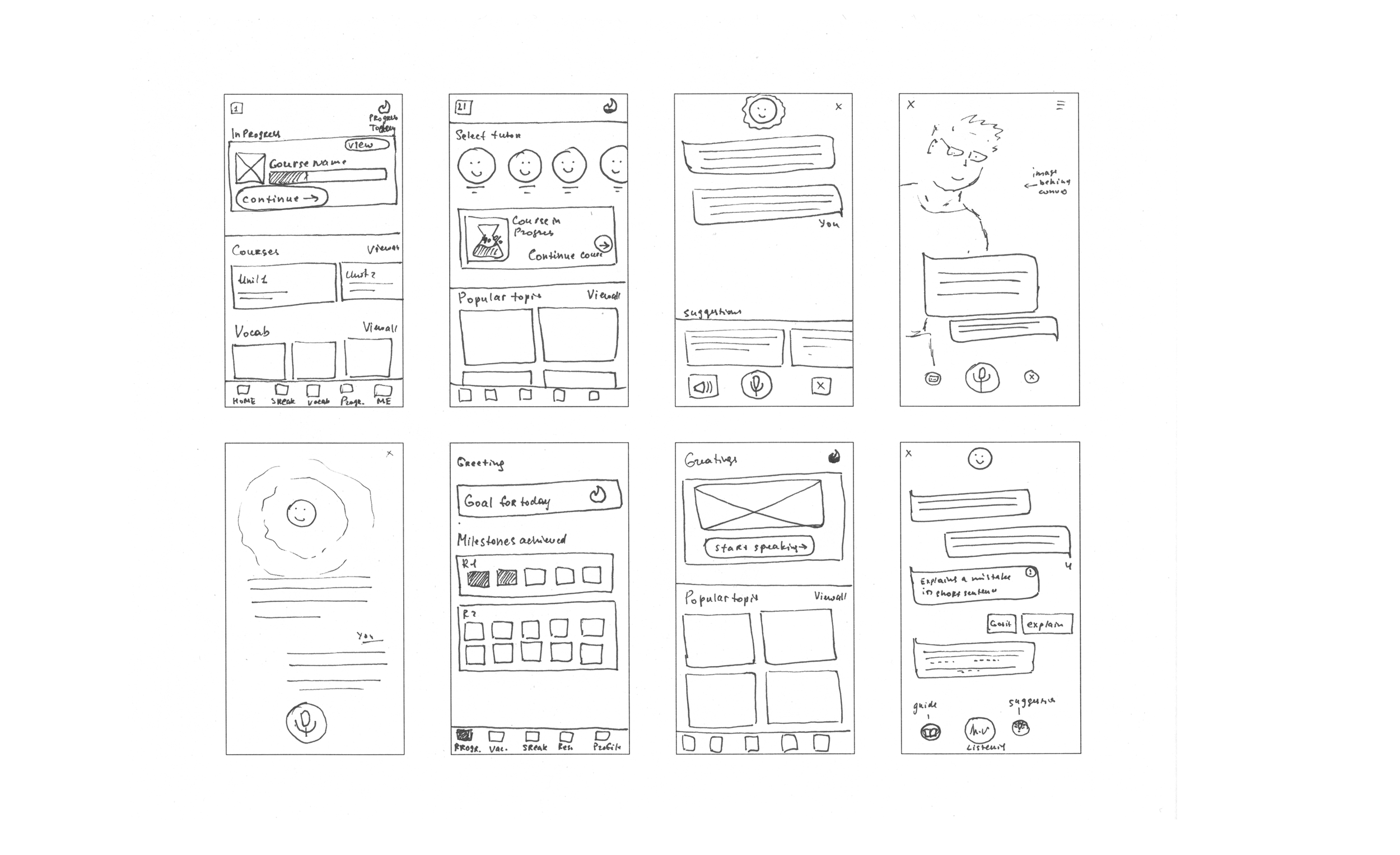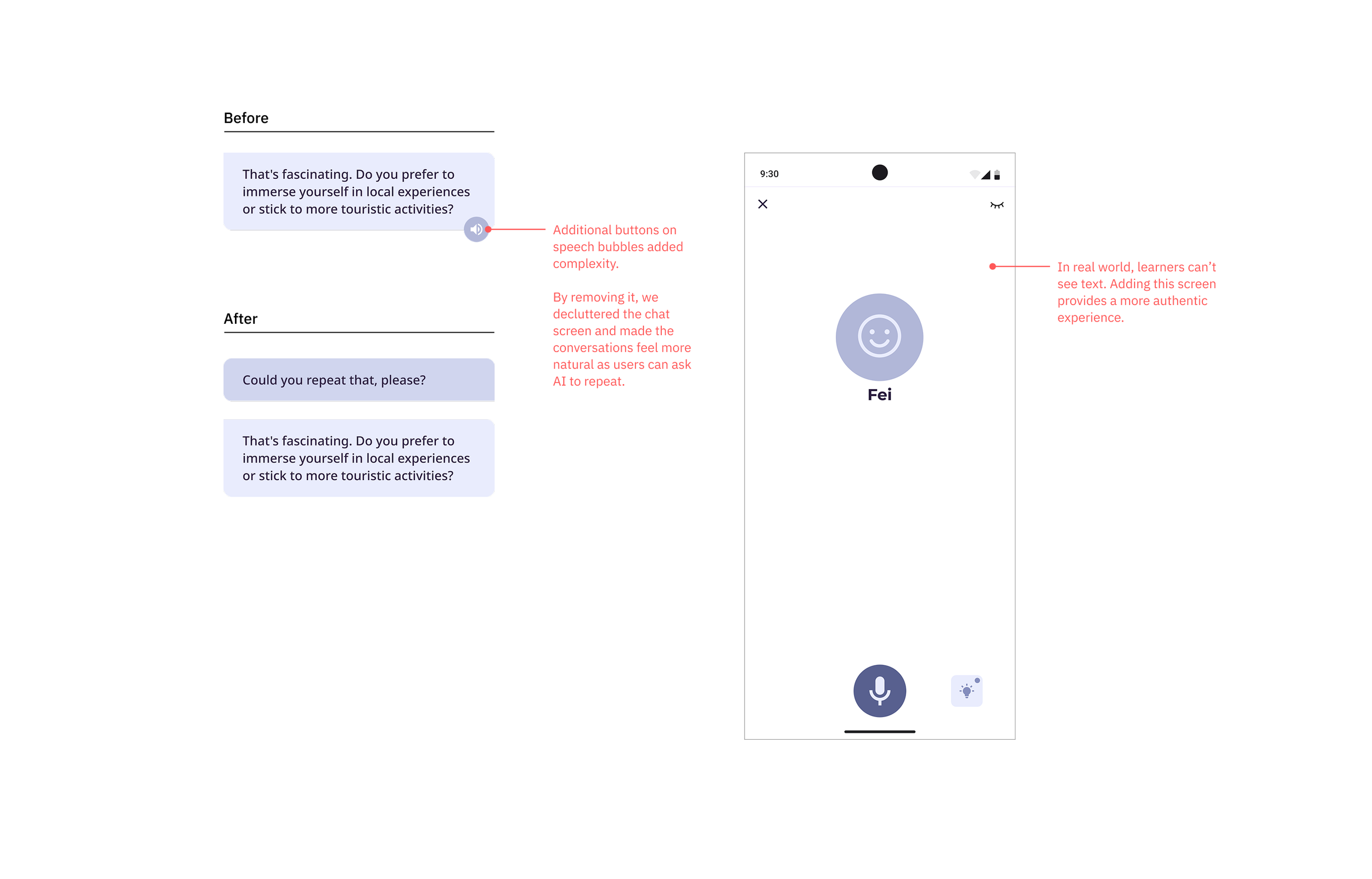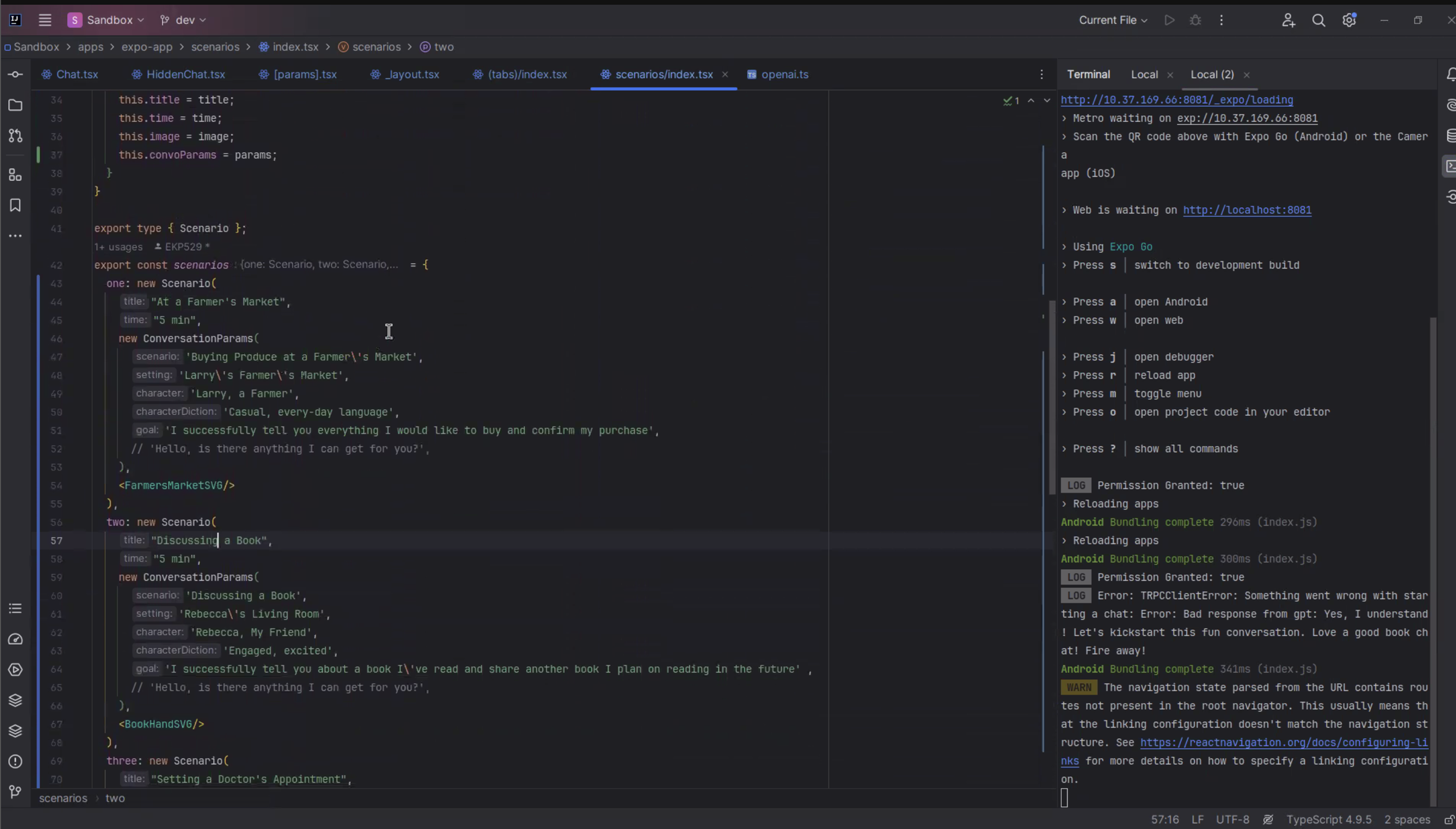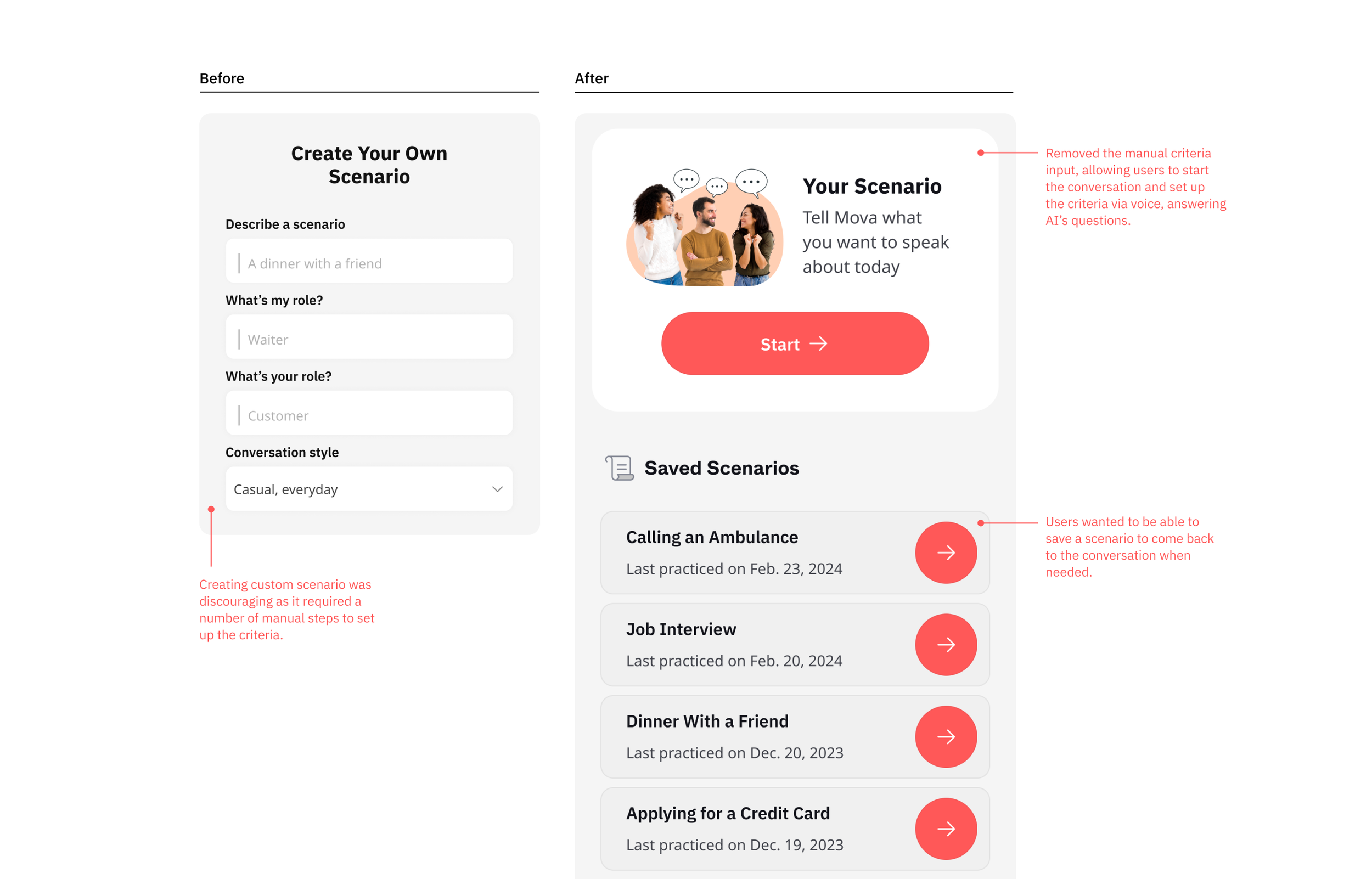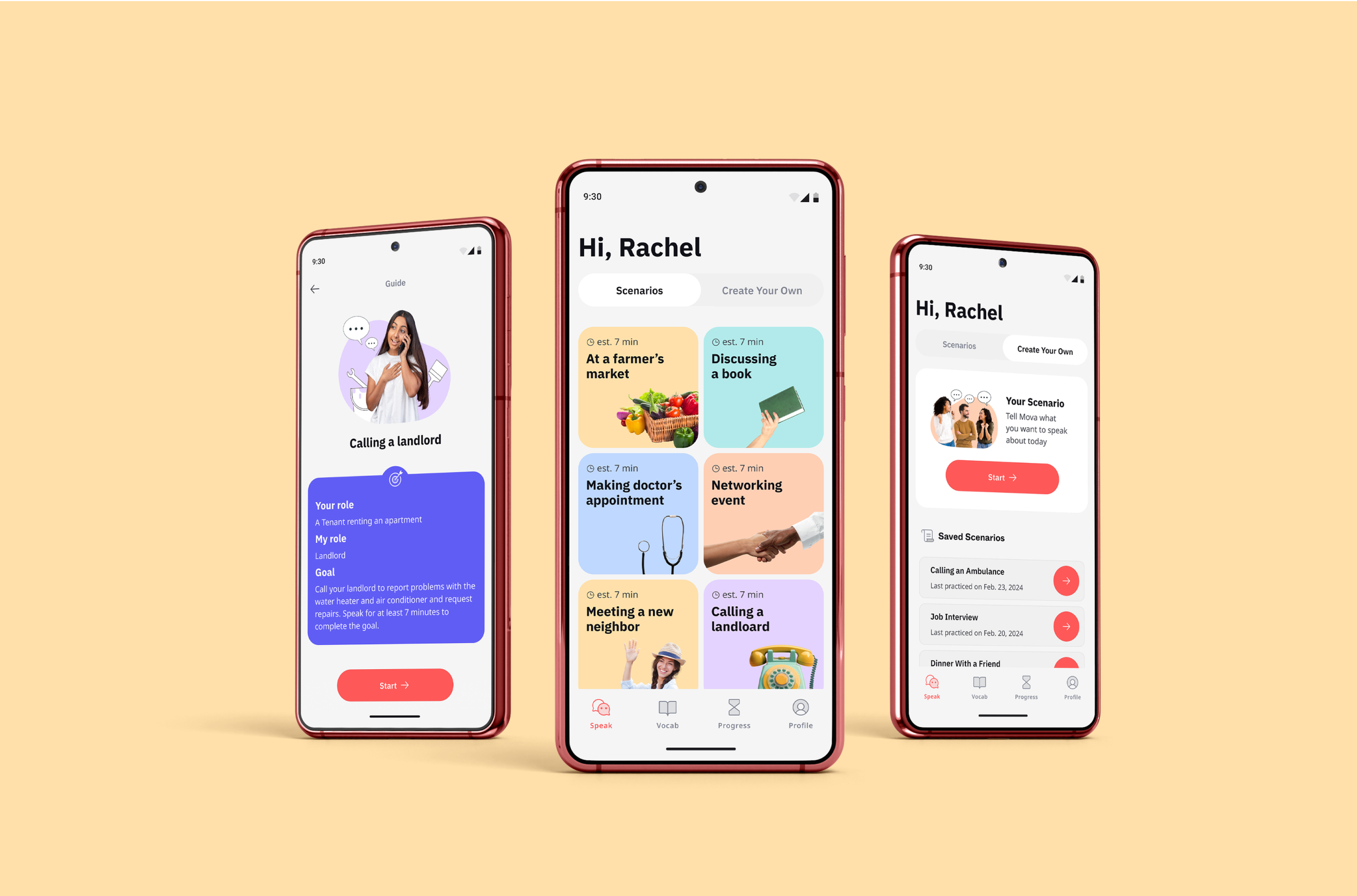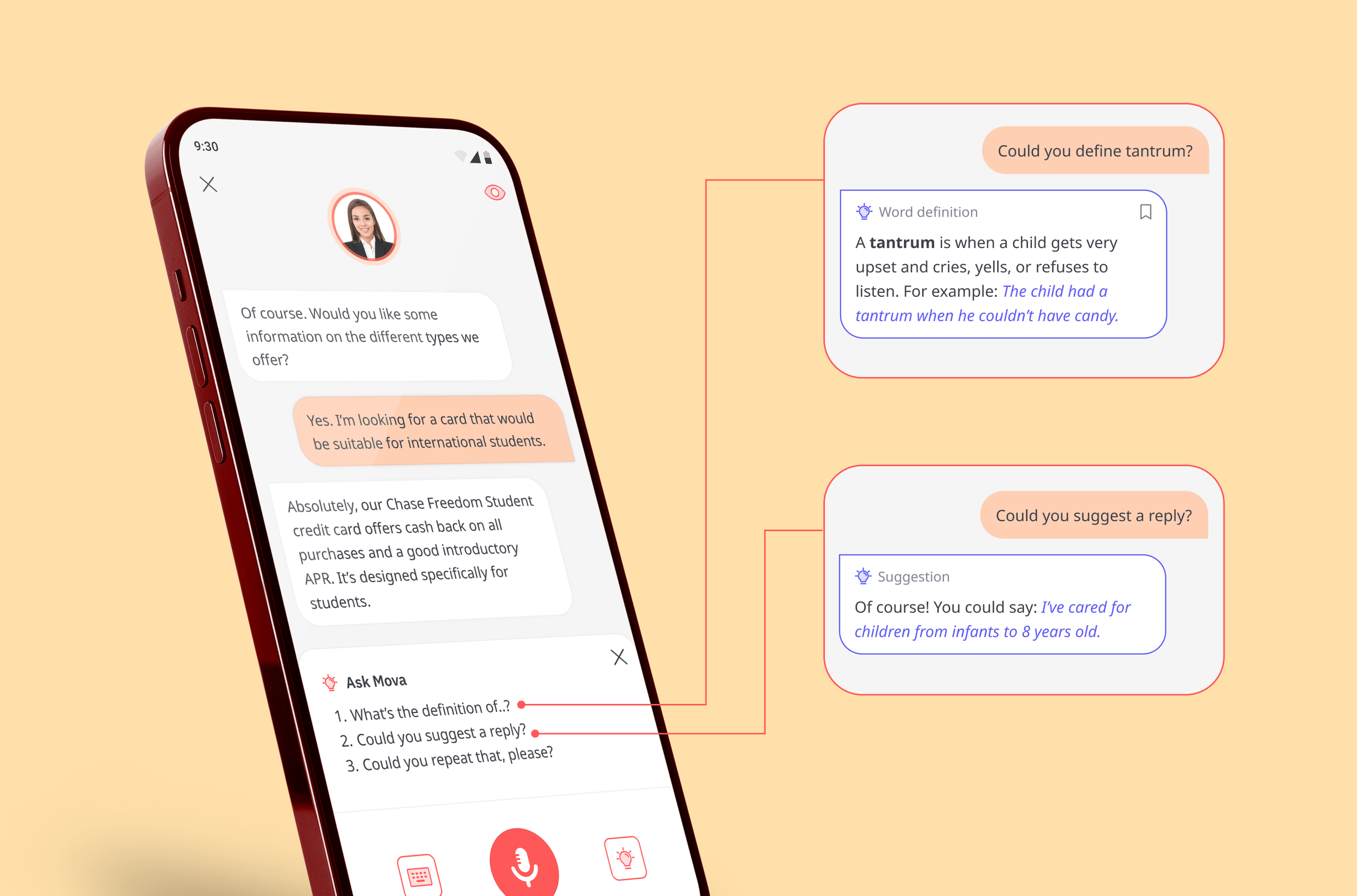Mova–Speak English Like a Native
A personalized AI tutor to help non-native speakers in the US build confidence in spoken English and improve their social, economic, and personal well-being. This project was part of Sandbox (accelerated startup building program) at BYU.
TEAM
Product Manager / Co-founder: Kyle Kohn
Developer: Eden Paupulaire
Developer: Trisha Chandramouli
MY ROLE
Co-founder, UX/UI Design, Research, Branding, Brand Strategy
DURATION
September 2023—May 2024

THE LANGUAGE CHALLENGE
Without strong English skills, non-native speakers face social and economic challenges.
WHAT WE DID: AI TUTOR IN YOUR PHONE
We built an AI-powered app that provides English learners with speaking practice and real-time feedback to build confidence.
RESULT: 30 USERS SIGNED UP FOR BETA
We Beta tested the app with 30 users, through which we received positive feedback and gained one paying customer.
Going back to my language learning and teaching experience
NO PRACTICE, NO FLUENCY
My personal experience in both learning and teaching a foreign language provided a good foundation for our hypothesis that speaking is the hardest part of language learning, especially when there is lack of regular practice.
speaking without regular practice is one of the hardest parts of language learning
But my experience isn't euqal to others...
WHAT DO OTHERS SAY
To validate our hypothesis and discover additional insights, we started with a high level survey and followed with interviews. With 25 survey responses, we confirmed our initial thought.
78% of the research participants confirmed that speaking was the hardest part of language learning
But why…
INTERVIEWING LEARNERS AND TEACHERS
We continued our research with in-person interviews of English learners and teachers. We included teachers to get a wider perspective on the problem. While interviewing the teachers we stumbled upon insights of what challenges teachers experienced in their teaching experience and their needs.
Sophia, 33, a former math teacher and mother of two, recently moved to the U.S. and is actively seeking work to restart her career.
“As a foreigner recently moved to the US, I need to be able to speak English with confidence, so that I feel a sense of belonging in my community.”
01. Fear of Making Mistakes While Speaking
72% research participants said they feel anxiety when speaking English due to fear of making mistakes.
Sophia
“I need to practice speaking regularly, so that I overcome my fear of making mistakes.”
02. Struggle to Speak the Right Way
Almost half of people said that they develop incorrect speech habits because they don’t get corrected when talking with friends or others.
Sophia
“I need to practice speaking regularly, so that I overcome my fear of making mistakes.”
03. No Time For Traditional Classes
64% research participants say they struggle to keep up with traditional ESL in-person classes due to busy schedule and as a result don’t have consistent practice.
Sophia
“I want to be able to fit speaking practice in my busy schedule, so that I stay consistent with my learning.”
04. Struggle to Use New Words
About three-fourths of the research participants say they struggle to use new words in conversation due to lack of contextual learning.
Sophia
“I want to be able to use new words in conversation easily, so that I can express myself better.”
How Might We…
01.
How might we create a safe environment for learners to practice speaking without fear?
02.
How might we make speaking practice more flexible and accessible for busy learners?
03.
How might we help learners to start using new vocabulary in conversations?
04.
How might we give instant, supportive corrections that encourage learning?
Most competitor apps focus on pronunciation or general language learning for a broad audience, offering limited support for realistic conversation practice. They lack personalized feedback and human-like corrections, leaving gaps in speaking fluency.
Brainstorming app features
PROBLEM
01-02. Anxiety speaking & time
How might we create a safe environment for learners to practice speaking and provide flexibility for busy learners?
01-02. AI tutor
Utilize AI to offer flexible practice schedule and a safe space to speak without fear of making mistakes.
03. Using new words
How might we help learners to start using new vocabulary in conversations?
03. Guided conversations
AI tutor encourages learners to apply new words in context during a conversation.
04. Learn to speak correctly
How might we give instant, supportive corrections that encourage learning?
04. Immediate corrections
Have AI immediately correct mistakes during the conversation and suggest further explanations.
SOLUTION
Designing from paper to screens
More customization added after user testing
SETTING UP PROMPTS FOR PREDESIGNED SCENARIOS
In collaboration with engineers, we refined the prompt template for each predesigned scenario. We considered factors like response length, user flexibility to deviate from the topic, and how AI provides corrections to ensure a natural and effective learning experience.
Brand identity inspired by my Ukrainian roots
MOVA IS UKRAINIAN FOR “LANGUAGE” OR “SPEECH”
I chose the name Mova because it means "language" or “speech” in Ukrainian, directly connecting to the app’s purpose while also reflecting my heritage. It is short, clear, and easy to pronounce across different languages. The soft "M" and open vowel sounds evoke a sense of warmth and approachability, and its clarity and brevity makes it an ideal name for a language learning app focused on confident communication.
Testing the working app uncovered valuable insights
After multiple rounds of testing and continuous improvements of lo-fi and hi-fi designs, we built a functional MVP and tested it with 5 users. Their feedback helped us identify areas for improvement, and we iterated after each round to refine the experience. I made the following changes to the design, not all of which were implemented into the working app and still had to be tested with users.
Final designs
STARTING A CONVERSATION
Users can select a scenario from a list of suggested predesigned conversation topics or create their own scenario by answering AI’s questions about the situation and the roles.
CHAT OR VOICE ONLY
Learners can move up to the next level and speak with Mova without looking at the text.
TUTOR’S ASSISTANCE DURING A CONVERSATION
Learners can ask Mova to suggest a reply if stuck with what to say. They also can ask Mova to define a word they can save to practice later.
AUSING NEW VOCABULARY IN CONVERSATION
Create your sets of vocabulary you want to practice using in a conversation. View the list of words with their definitions and examples before practicing. Practice using the word in a conversation, by answering AI’s questions.
REVIEWING MISTAKES
Learners review the mistakes and get a score after completing a conversation.
Learnings and next steps
NEXT STEPS
Test the button behavior and continue iterating on its design to ensure users understand and use it correctly.
Even though users highly value the chat view, evaluate how much on-screen text is actually necessary during conversations.
Explore ways to tailor conversation scenarios for learners at different proficiency levels.
Continue collaborating with users to make the speaking practice even more relevant to their situations.
WHAT I LEARNED
Overcoming Action Bias: Overthinking slowed us down at first. I learned, it’s better to build something, put it out there, and get real feedback. Answers come from users, not assumptions.
Speak Up About Issues: Giving honest feedback is hard, but it matters. Say what doesn’t work, why, and what could be better.
Don’t Be Afraid to Let Go: Every project may feel hard to let go, but knowing when to move on is key. Letting go creates space for what really works—and new opportunities always follow.
PROJECT OUTCOME
We gathered enough beta users to launch the app on the Google Play Store and even secured a paying customer, showing early interest. However, after Sandbox ended, each team member pursued different paths, and without solid proof of the app’s viability, we decided to discontinue the project. Despite this, the experience provided valuable insights into product development, collaboration with team members, and startup challenges.






